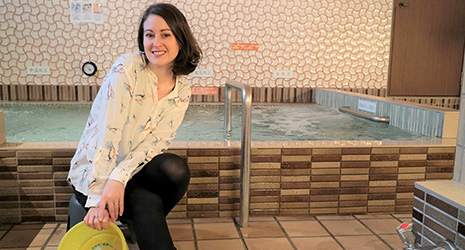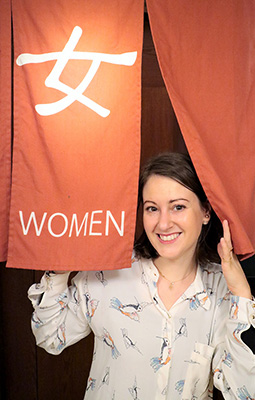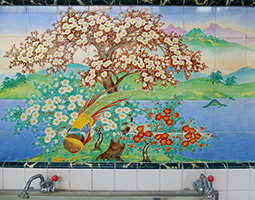Home > Highlighting JAPAN > Highlighting Japan March 2017 > Home Away from Home
Highlighting JAPAN


The Bathhouse Ambassador
Stephanie Crohin from France shares the beauty of sento bathhouse culture from her home in Tokyo with readers around the world.
Sento public bathhouses have their origin in the sixth-century bathing halls of Buddhist temples. The bathhouses were primarily a facility for monks to purify themselves, but the temples also provided hot water to the sick and poor in accordance with the teaching that ablution prevents diseases. These temple baths became the prototype for the modern-day sento, a public bathhouse accessible on payment of a fee. In the Edo period (1603–1867), many sento were constructed across the country. To this day, sento are cheap to enter, the Tokyo Sento Association for example having fixed the fee in the capital at just 460 yen (about 4 US dollars) for those age 12 or older.
Stephanie Crohin from France is a well-known sento journalist living in Tokyo. So enchanted is she by sento culture that she has now visited almost 600 bathhouses across Japan.
“I was first invited to a sento by my classmate in 2008 when I was studying in Japan. At that time, I couldn’t speak Japanese well, but it was fun to chat with the regulars while soaking in the hot bath. I was moved by the gentle world of the sento.”
After further studies in France, Crohin returned to Japan in 2012 with a job in the beauty industry. Remembering the pleasures of the sento she had visited as a student, she relieved her work fatigue by going to the sento every week.
Crohin soon created a website, Dokodemo Sento (“Dokodemo” means everywhere in Japanese), and other social media platforms to share the charms of sento with readers around the world. Crohin posts beautiful pictures of sento on Instagram on a regular basis and has attracted hundreds of followers. Crohin receives emails almost every day, she says, from people around the world who plan to travel to Japan and visit a sento as part of their sightseeing itinerary.
The Japan Sento Cultural Association, which works to disseminate Japanese sento culture, appointed Crohin as its first Sento Ambassador in 2015 in recognition of her publicity work. Since then, Crohin has been promoting sento culture in earnest — researching, taking photographs, writing articles, giving lectures and appearing in the media as a sento expert.
Crohin identifies three main charms to the sento.
The first is the baths’ positive impact on health and beauty. “Because sento use groundwater, the quality of the hot water is high and seems to warm your body from the inside,” she explains. “The water is good for your skin. It is also good for your mental health. You feel refreshed after a visit to a sento even if you have been experiencing difficulties or stress.”
The second charm of the sento is the beautiful and unique artwork on display therein, typically large-scale murals on the bathhouse walls. Many murals are paintings depicting Mount Fuji and its foothills; others may be tile mosaics of abstract design.
“When I went to one sento in Kyoto which is well known for its use of Majolica tiles, I gasped out loud despite myself,” says Crohin. “In addition to the wonderful interior murals, in Tokyo there remain a few old sento built in the miyazukuri (shrine-shaped) style resembling a shrine or temple. I pray that these buildings will be preserved in the future.”
The third charm of the public bathhouse is the community aspect, says Crohin. “Because a sento is often located in the center of a neighborhood, it’s a great place to gather local information. When I travel to the countryside, for example, I make sure to go to a sento first and get tips about the good restaurants in the town from the regulars.”
In an effort to raise awareness of the pleasures and benefits of the sento, the bathhouses now sometimes serve as temporary exhibition or concert venues. Towel stamp rallies have also been promoted.
Crohin regards such collaborative projects with other businesses or artists as being an important way forward for sento today.
“I saw a wonderful case recently of a sento using lemons in the bathtub that had been cultivated by a local farmer who uses organic methods,” says Crohin. “Taking advantage of my position as the Sento Ambassador, I hope to help boost sento fast by connecting people.”
© 2009 Cabinet Office, Government of Japan








